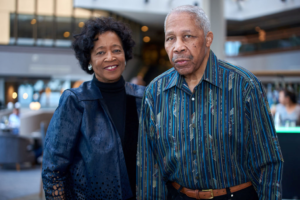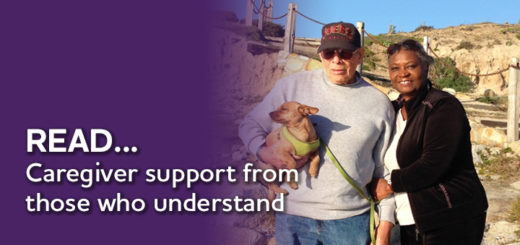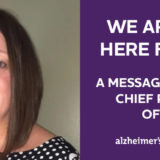San Mateo caregiver reaches out to help others
Gloria and Arthur Brown are living proof of the adage that it takes a community — a caring and committed community — to support a loved one with Alzheimer’s disease.
The San Mateo couple have been married for 51 years, and Gloria has been Arthur’s primary caregiver since 2015, when he was first diagnosed with Alzheimer’s.
Arthur’s care team
For 4 years, Gloria says, it has been a coordinated team effort to care for Arthur. That team that Arthur and Gloria rely on consists of:

- Their son, Arthur, who travels up from Southern California when his help and companionship is needed;
- An “exceptionally supportive” church community;
- Fellow members of the Bay Area Community Health Advisory Council, which Gloria helped to organize in 1995 (originally called the African American Community Health Advisory Committee);
- Good friends from high school;
- Local law enforcement officers: “I have a good relationship with law enforcement. I’ve had to be proactive “¦ because of some incidents and situations with Arthur”; and
- A home health aide.
“I know a lot of people, and when this happened to us, people just rallied around us,” Gloria shared. “I can call upon any of them. But I don’t like to abuse the privilege of calling them.”
Caregiver self-care
Gloria also knows the importance of taking care of herself in her role as Arthur’s primary caregiver. She remains active in community programs, especially the health advisory committee.
“It’s for my own sanity,” Gloria explains. I’m still involved in a number of things – it’s important for my own mental well-being.”
She meditates, goes for long walks. “I do what I need to be rejuvenated,” she adds. “I can’t take long trips anymore — so I take short drives — figuring out what the next steps are going to be to make Gloria happy. We want to keep the person with Alzheimer’s happy and we also want to keep the caregiver happy.”
Patient, positive and realistic
Gloria is a realist when it comes to Arthur’s prognosis. “I think I have a pretty healthy outlook on this. I know it’s something that’s not going to get better,” she says. “I make the situation as comfortable and best as I can. That’s what I try to do.
“I’m not in denial. I have a couple of friends who are in total denial. And I think they’re just unfortunately making it worse for themselves.
“I have learned to be very patient and very flexible. When I keep the routine going, it seems to work better. But that isn’t possible every day. Life happens.”
Looking back on the first signs
Like so many others with Alzheimer’s, Arthur showed early signs of the disease prior to his formal diagnosis.
He would leave his coffee cup full of hot coffee in a kitchen cabinet. He’d run out to buy ice cream and then forget it in the car, leaving it to melt when he returned home.
He forgot how to get to their favorite restaurant: “It got to the point of him calling,” Gloria says, “and asking, “˜Now where am I going? And how do I get there?'”
After Arthur failed an initial exam required for long-term care insurance, he went to his doctor for additional testing. When they received Arthur’s Alzheimer’s diagnosis, Gloria was probably more prepared than many — owing largely to her active involvement in the local health advisory committee.
A forum for education
African Americans represent a small population in San Mateo County, but Gloria says health issues for her community were “off the charts.” That prompted her and others to form the health advisory committee, with an emphasis on studying and promoting prevention and screening.
“We covered the gamut of topics — Alzheimer’s, heart disease, diabetes — Bay Area wide,” Gloria shared. “We devoted ourselves to educating our communities, especially our communities of color.”
Helping herself through helping others
After Arthur was diagnosed with Alzheimer’s. Gloria reached out to the Alzheimer’s Association and partnered to put together a three-part educational program.
The program covered:
To ensure that as many people as possible could benefit, they set up an 800 number so people could call in for all three of the sessions.
Gloria shared some of her tips to help people living with dementia and caregivers:
- Get as much education as you possibly can.
- Find out about the resources available in the community to help you.
- Share information with others about what is happening.
- Know that there was nothing that you or the person with Alzheimer’s did to bring on the disease.
- Keep an open mind towards this disease.
Putting a face to Alzheimer’s
Gloria is a strong advocate for the Alzheimer’s Association’s education and information programs, particularly the Living With Alzheimer’s and Savvy Caregiver education programs. She appreciates the efforts of the Alzheimer’s Association to ensure that materials and representatives are culturally appropriate for communities of color.
Gloria is committed to sharing what she has learned about caregiving with others in the African American community. “I think it’s just going to take more people like myself who are comfortable in talking about their loved ones who have Alzheimer’s to get that message out to others to take advantage of the resources,” said Gloria.
“It’s like how breast cancer used to be taboo to talk about. Then we started showing the faces of people in the community who are breast cancer survivors and it made a big difference. We just need to find ways to make that happen with Alzheimer’s — people who are willing to share, to put a face to the disease.”
Learn more:

















